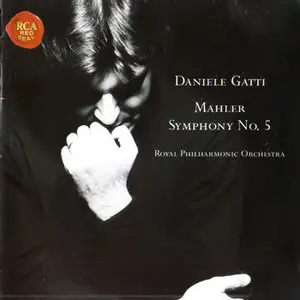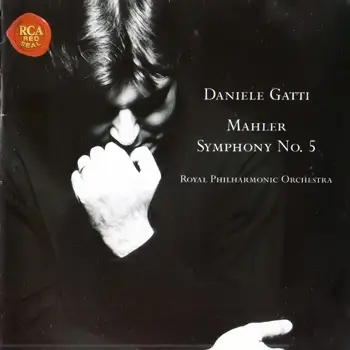Gustav Mahler: Symphony No. 5 in C sharp minor - Royal Philharmonic Orchestra; Daniele Gatti
Classical | 1 CD | EAC Rip | 296 MB, 3% recovery | FLAC+LOG+Cue | Complete scans | RS links
Publisher: RCA Red Seal/BMG | Recorded: 1997 | Published: 1998
Don't let the very opening put you off. Daniele Gatti takes his cue from Mahler's injunction that the upbeat triplets of the trumpet theme should be played somewhat hurriedly, in the manner of military fanfares, and throughout the movement he is wont to place the material in inverted commas. Such a treatment put me in mind of Nikolaus Harnoncourt's destabilizing way with the opening phrases of Mozart's Jupiter Symphony — its over familiar gestures distorted or refreshed depending on your point of view. Not that there is anything severe or intellectual about Gatti's Mahler. Here, rather, is an (expertly prepared) eruption of youthful enthusiasm, a display of heart-on-sleeve lyricism to make Riccardo Chailly's recent version seem chilly and uncommunicative.On this CD:
In the subsequent movements, no one is likely to confuse Gatti's flexible rubato with mere mannerism. The wide dynamic range is impressive but subtlety of inflexion is the conductor's trump card. So while the second movement is an almost 0 frantic and at times formidably loud tour de force, the famous Aclagietto is uncommonly slow and sensitive. For the most part, too, Gatti coaxes a properly middle-European sound out of his wind and brass, and, if the RPO's strings cannot yet match those of Vienna, Berlin or Amsterdam, their sound is surprisingly full and rich. Indeed, the musicians sound so grandly confident that the few lapses perhaps seem worse than they are. The finale is again thrillingly extrovert, quite without heaviness.
In short, this is something of a triumph for all concerned. The RPO show just what they can achieve given adequate rehearsal time and Andrew Keener's production team makes the very best of London's Henry Wood Hall. Above all, Gatti deserves high praise for what must be counted the freshest, most natural-sounding Fifth we have had for a long time. It is a reading with a uniquely radiant atmosphere and one that I would urge you to add to your collection even if your instinct is to trust to grander symphonic visions and bigger names. DSG; The Gramophone***
In terms of sound, Daniele Gatti's recording of the Fifth with the Royal Philharmonic Orchestra on Conifer (75605 51318 2) is one of the best before us. It's a close-in balance with every detail sharp and clear, almost like having the score in front of you. It was made in Henry Wood Hall which is where the London orchestras rehearse, so there wouldn't have been much room for vast reverb which I don't think is suited to this work anyway. It is also, as we shall see, a sound picture well-suited to Gatti's interpretation. The playing is exemplary. There isn't a department unprepared for the demands placed on them with brass especially virtuoso in passages when they are going all out. It's a reading that stresses symphonic structure, eschewing overt expression or emotion, clear-sighted, clear-headed, pure-minded, an almost calculated realisation of the score but saved by a crucial sense of drama and travail that convinces brilliantly. So the opening trumpet fanfare is meticulously spaced to an extent you don't often hear. Arresting when done like this because it has the effect of lingering in your mind right through the movement, as it should. The clear-sightedness is maintained when the funeral march gets under way as the "dragging" many conductors adopt here is not in Gatti's imagination. When he reaches the marking "Suddenly faster. Passionate. Wild" the sharp, bold lines of the reading accentuates a feeling of energy. This is Mahler decisively for the head rather than the heart - not on the sleeve, at least. With the return of the main funeral material Gatti shows he wants to compartmentalise Mahler's material in an almost manic sense of organisation. As if his firm hand on the material is all that's keeping us from chaos and, for me, this soon sets up a special kind of tension missing from similar kinds of readings. The end of the second Trio, right at the end of the movement, marked "Klagend" is delivered like a guillotine followed by an impressive, snarling descent into oblivion.
The second movement is fast, furiously so in parts. At the beginning I liked the sound of the basses digging into the strings and then, soon after, the precise chattering of the woodwinds whose presence here will never flag. Gatti's insistence on a tempo just a little faster than we are used to in the really fast sections keeps the sonata form structure of this movement in our minds. The cello's lament at 188, the eye of peace in the hurricane, is likewise that little bit more flowing than usual. None of the heavier emotional pull of Shipway or Bernstein or Morris, for example. But the passage is not so fast it fails to make its effect. Here is a conductor careful to want each episode to slip into the next without having to take any kind of evasive or dramatic action. The section leading to the great chorale cross-beam also refuses to yield to the moment. Unkind souls might say Gatti is too anxious to get us to it, and there's no doubt that, compared with others, some power is lost in exchange for movement and the clear head. But the arrival of the chorale is all you wish for in terms of reaching a "way point" in the symphony.
Purity is the word that springs to mind for the Scherzo: purity of sound and expression. The opening is characterised by more sharp lines and vital rhythms, but even Gatti can't help himself relaxing his guard for moments of repose. There is an air of "Forgive me a moment but I can't help myself" about it. The impression in Daniele Gatti is of a serious young man anxious not to offend, careful not to appear too gauche or on anything other than his best behaviour. As I said earlier, that can set up its own tension but can also undermine music that actually needs more "heft" and abandon. But there is much to admire and enjoy here. As the movement progresses, the unwillingness of Gatti to yield to the greater lyricism of this movement, the place where the two violently contrasting and opposing worlds of feeling in the symphony pivot, fails to win the movement deep place in the emotional structure in anything but a superficial way but succeeds well in the story of the symphony‘s journey from dark to light. Other conductors - Shipway, Barbirolli, Bernstein, Schwarz, Tennstedt - take us deeper into the nooks and crannies but it’s a near thing.
The Adagietto flows well and the central section with its faster tempo is more muscular. When the slower tempo is asked for towards the end, because the initial tempo was faster than we are often used to, the singing line is maintained well. The Finale is a great virtuoso display and goes along with real bounce and wining verve. Other conductors can bring more warmth and humour to this movement where Gatti seems to want to maintain his sharp concentration to the end. He does raise the orchestra to a fine peroration at the close, though, and is more than satisfying as a conclusion to this great work. I don't want to seem harsher in my judgement of this recording than I am. It is a worthy contender and I recommend it. - Tony Duggan
GUSTAV MAHLER: Symphony No.5 in C sharp minor
Part I
1. First movement: Trauermarsch (in gemessenem Schritt - Streng - Wie ein Kondukt) 13:01
Ian Baimain, trumpet
2. Second movement: (Stürmisch bewegt, mit größter Vehemenz) 14:08
Part II
3. Third movement: Scherzo (Kräftig, nicht zu schnell) 17:18
John Bimson, horn obbligato
Part III
4. Fourth movement: Adagietto (Sehr langsam) 10:12
5. Fifth movement: Rondo - Finale (Allegro) 14:56
Total playing time 69:56
Recorded for Conifer Classics 15 - 17 November 1997 in Henry Wood Hall, London
Exact Audio Copy V1.0 beta 1 from 15. November 2010
EAC extraction logfile from 4. May 2011, 18:52
Royal Philharmonic Orchestra & Daniele Gatti / Gustav Mahler: Symphony No.5
Used drive : ASUS DRW-1814BL Adapter: 2 ID: 0
Read mode : Secure
Utilize accurate stream : Yes
Defeat audio cache : Yes
Make use of C2 pointers : No
Read offset correction : 6
Overread into Lead-In and Lead-Out : No
Fill up missing offset samples with silence : Yes
Delete leading and trailing silent blocks : No
Null samples used in CRC calculations : Yes
Used interface : Native Win32 interface for Win NT & 2000
Used output format : User Defined Encoder
Selected bitrate : 896 kBit/s
Quality : High
Add ID3 tag : No
Command line compressor : C:\Program Files\Exact Audio Copy\FLAC\FLAC.EXE
Additional command line options : -V -8 -T "artist=%a" -T "title=%t" -T "album=%g" -T "date=%y" -T "tracknumber=%n" -T "genre=%m" %s
TOC of the extracted CD
Track | Start | Length | Start sector | End sector
––––––––––––––––––––––––––––-
1 | 0:00.00 | 13:08.50 | 0 | 59149
2 | 13:08.50 | 14:17.65 | 59150 | 123489
3 | 27:26.40 | 17:23.00 | 123490 | 201714
4 | 44:49.40 | 10:12.45 | 201715 | 247659
5 | 55:02.10 | 14:59.53 | 247660 | 315137
Range status and errors
Selected range
Filename G:\MUSIC COPIES\NOVO\Mahler - Symphony No. 5 - Gatti\Royal Philharmonic Orchestra & Daniele Gatti - Gustav Mahler- Symphony No.5.wav
Peak level 99.8 %
Extraction speed 3.1 X
Range quality 99.9 %
Test CRC FDE52B05
Copy CRC 6B092B07
Copy OK
No errors occurred
AccurateRip summary
Track 1 accurately ripped (confidence 7) [DE9C1DFF]
Track 2 accurately ripped (confidence 7) [A73B5695]
Track 3 accurately ripped (confidence 7) [CA5B0DB6]
Track 4 accurately ripped (confidence 7) [728843F1]
Track 5 accurately ripped (confidence 7) [4C0DB31D]
All tracks accurately ripped
End of status report
==== Log checksum ACC3FB38CC7CF8894183E98297FB5E596119FE8334289DD61927B9370B21CCC5 ====
EAC extraction logfile from 4. May 2011, 18:52
Royal Philharmonic Orchestra & Daniele Gatti / Gustav Mahler: Symphony No.5
Used drive : ASUS DRW-1814BL Adapter: 2 ID: 0
Read mode : Secure
Utilize accurate stream : Yes
Defeat audio cache : Yes
Make use of C2 pointers : No
Read offset correction : 6
Overread into Lead-In and Lead-Out : No
Fill up missing offset samples with silence : Yes
Delete leading and trailing silent blocks : No
Null samples used in CRC calculations : Yes
Used interface : Native Win32 interface for Win NT & 2000
Used output format : User Defined Encoder
Selected bitrate : 896 kBit/s
Quality : High
Add ID3 tag : No
Command line compressor : C:\Program Files\Exact Audio Copy\FLAC\FLAC.EXE
Additional command line options : -V -8 -T "artist=%a" -T "title=%t" -T "album=%g" -T "date=%y" -T "tracknumber=%n" -T "genre=%m" %s
TOC of the extracted CD
Track | Start | Length | Start sector | End sector
––––––––––––––––––––––––––––-
1 | 0:00.00 | 13:08.50 | 0 | 59149
2 | 13:08.50 | 14:17.65 | 59150 | 123489
3 | 27:26.40 | 17:23.00 | 123490 | 201714
4 | 44:49.40 | 10:12.45 | 201715 | 247659
5 | 55:02.10 | 14:59.53 | 247660 | 315137
Range status and errors
Selected range
Filename G:\MUSIC COPIES\NOVO\Mahler - Symphony No. 5 - Gatti\Royal Philharmonic Orchestra & Daniele Gatti - Gustav Mahler- Symphony No.5.wav
Peak level 99.8 %
Extraction speed 3.1 X
Range quality 99.9 %
Test CRC FDE52B05
Copy CRC 6B092B07
Copy OK
No errors occurred
AccurateRip summary
Track 1 accurately ripped (confidence 7) [DE9C1DFF]
Track 2 accurately ripped (confidence 7) [A73B5695]
Track 3 accurately ripped (confidence 7) [CA5B0DB6]
Track 4 accurately ripped (confidence 7) [728843F1]
Track 5 accurately ripped (confidence 7) [4C0DB31D]
All tracks accurately ripped
End of status report
==== Log checksum ACC3FB38CC7CF8894183E98297FB5E596119FE8334289DD61927B9370B21CCC5 ====



